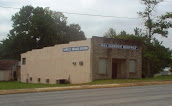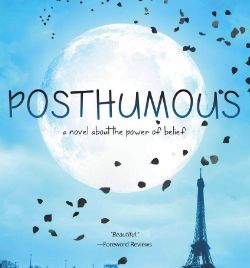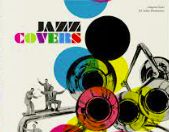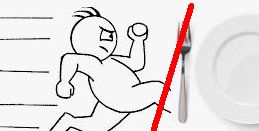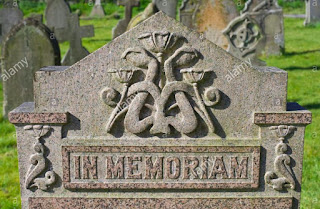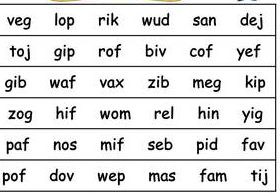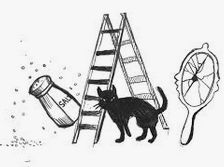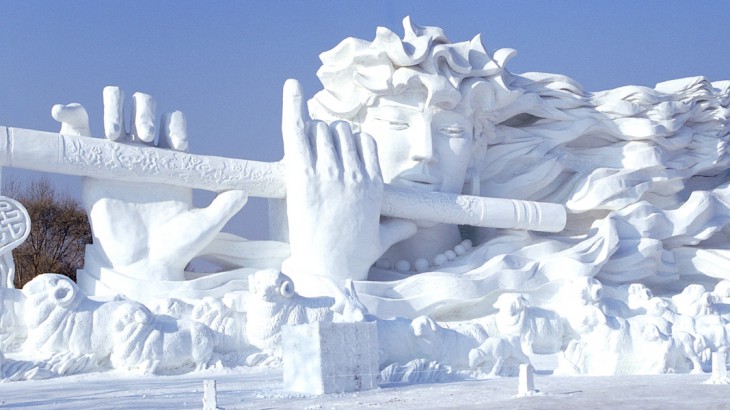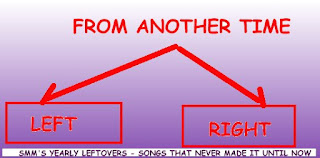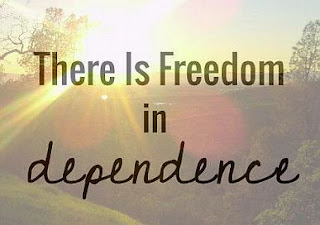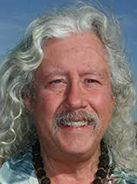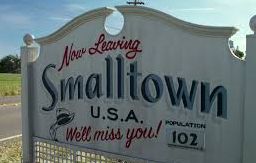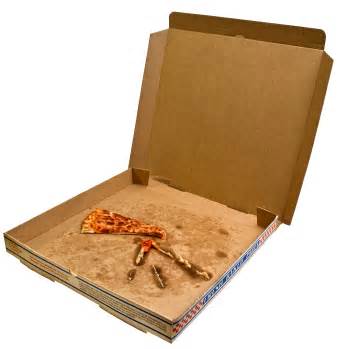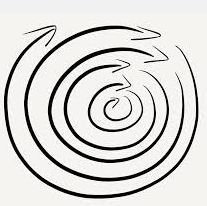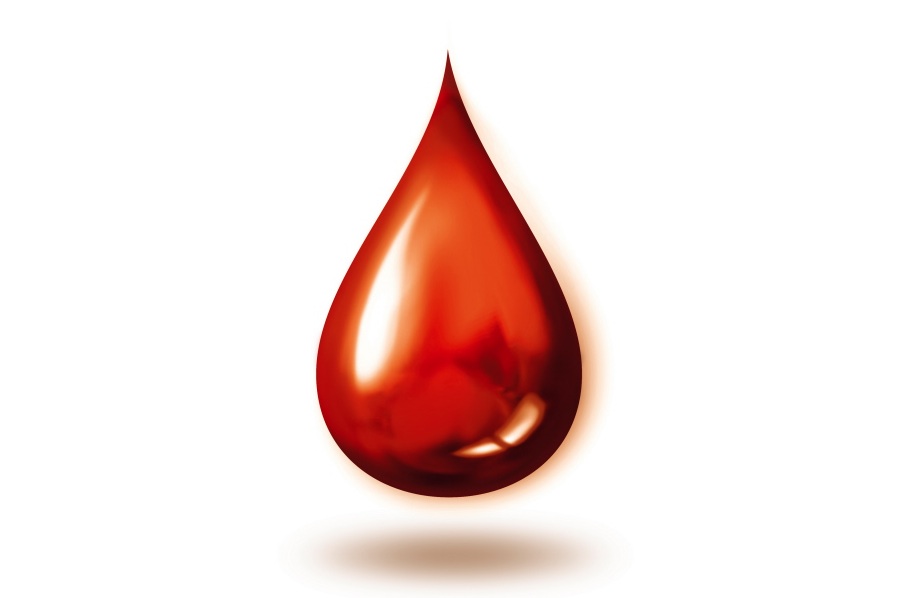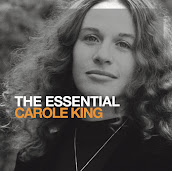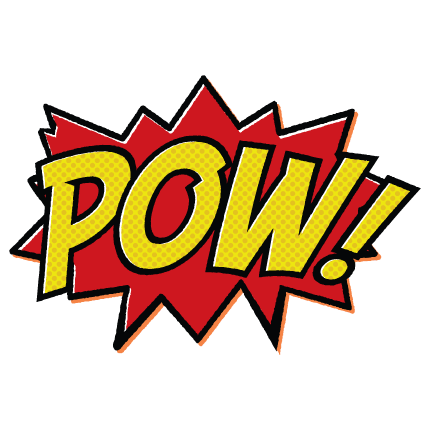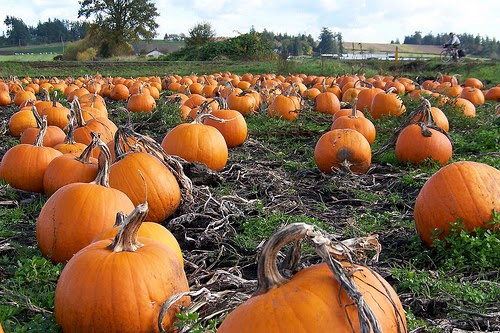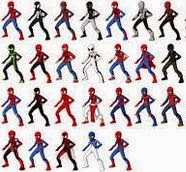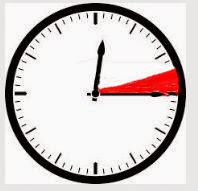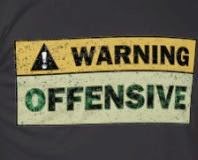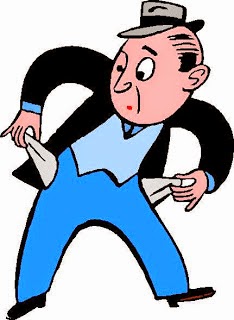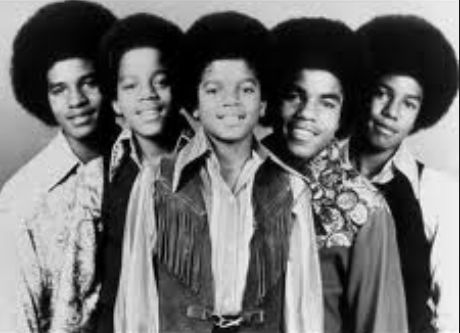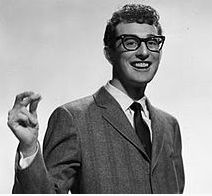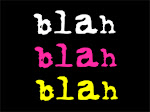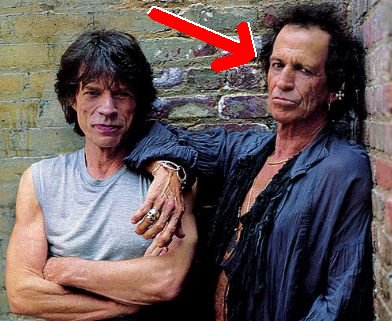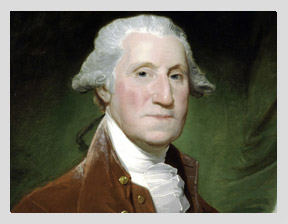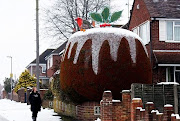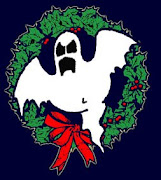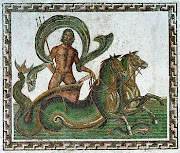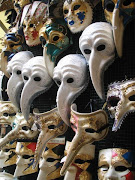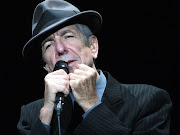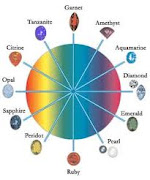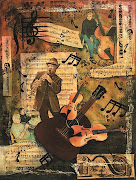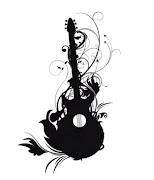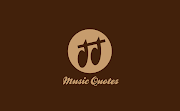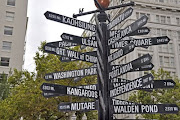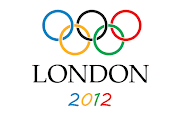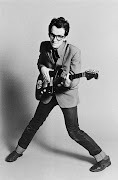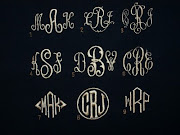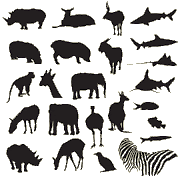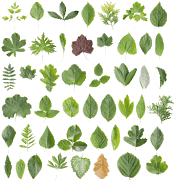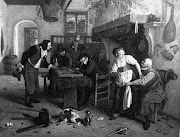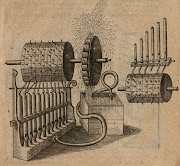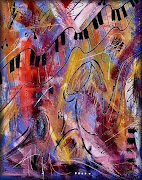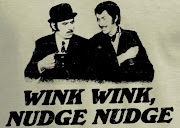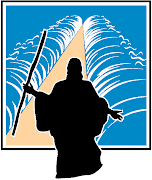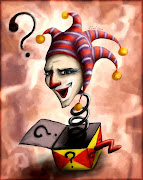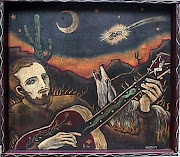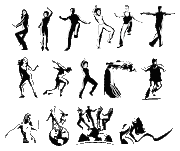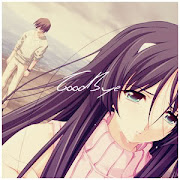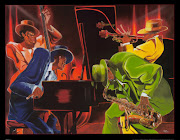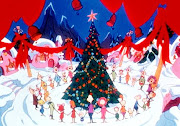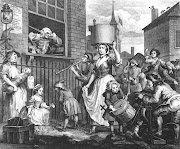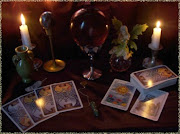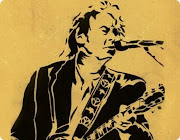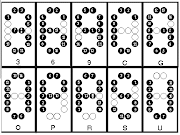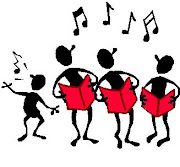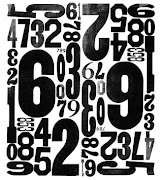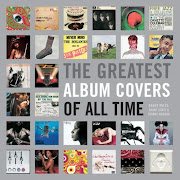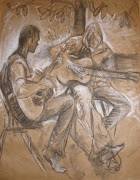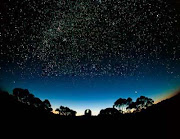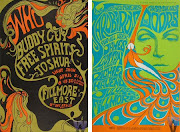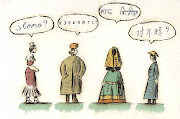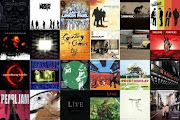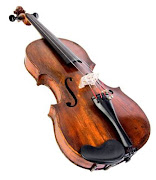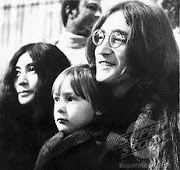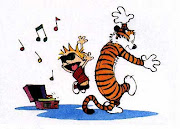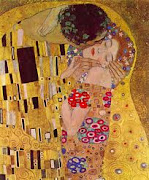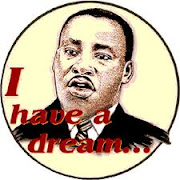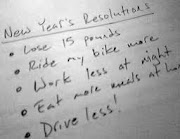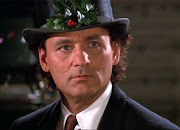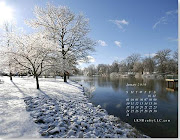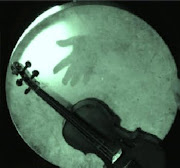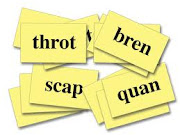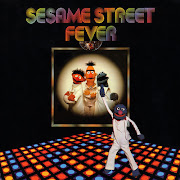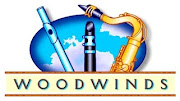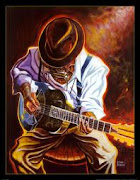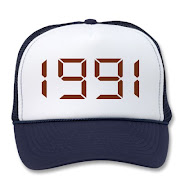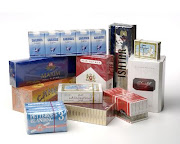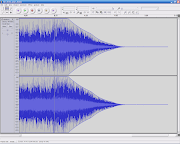Dave Carter and Tracy Grammer: Highway 80 (She's a Mighty Good Road)
[purchase] scroll halfway down to Drum Hat Buddha CD
Dar Williams: Spring Street
[purchase]
Buddy Mondlock: Magnolia Street
[purchase] - Poetic Justice CD
"From the dark end of the street to the bright side of the road" - those dirt, gravel and paved roads can be literal, but they are bound to be metaphor... of leading somewhere, running away from something or the journey itself...
All the songs above work through their darkness to a happy ending... of reunion, renewal and redemption, in that order:
The structure of Dave Carter's Highway 80 is unusual, as it has a repeating chorus, rare if you are familiar with his work - he also joked about it being a sing-along, hysterical when you read/listen to the lyrics fraught with names of towns that do not roll trippingly off your tongue. The song tells the story of a guy who allowed himself to be lured to California, looking for adventure, and found it lacking ("the water was cold and the beer was hot") - he talks to his woman on the phone, and she reassures (twice, in Tracy's twangiest voice) that she's waiting patiently on the other coast for his return...
Dar Williams' Spring Street finds our female protagonist experiencing an epiphany, realizing that she has to "walk the talk" to free herself from her stuck place ("but I'll push myself up through the dirt and shake my petals free, I'm resolved to being born and so resigned to bravery") - Spring Street is a state of mind, and she's already there...
Buddy Mondlock's Magnolia Street opens with the narrator in deep dilemma... he loves her, he loves her not... attempting to quantify the most complicated of all emotions - he soon understands, with the help of the wind and the mockingbird (adorably whistled in this live version by Jonathan Edwards; on the recorded version, it's a pennywhistle) that "we carry all this stuff around,we're not so deep we're just weighted down" (i.e., who needs to think when you can dance?)...
To hear/see the Van Morrison song I reference in my title, check out this video -"let's enjoy it while we can"...
Saturday, May 22, 2010
Street Names: Bright Side of the Road Edition
Posted by Susan at 5:00 PM View Comments
Labels: Buddy Mondlock, Dar Williams, Dave Carter, Street Names, Tracy Grammer, van morrison
Street Names: The Streets of Joni Mitchell Edition
Joni Mitchell: Sisotowbell Lane
[purchase]
Here we find Joni Mitchell at the beginning of her career, contemplating a street scene from a comfortable rocker on the front porch. The sight of various friends and neighbors trigger quick fond associations. Mitchell’s gift for these quick character sketches make Sisotowbell Lane feel like a real place, but was it? Here is a footnote from Jonimitchell.com:
Sisotowbell: A word Joni invented in 1966/67. As she would explain on Philadelphia radio station WMMR in March 1967, she was writing a mythology, the names of its various members derived from acronyms based on descriptive phrases. There were, for instance, a race of miniature women, the Posall ("Perhaps Our Souls Are Little Ladies"), and men, the Mosalm ("Maybe Our Souls Are Little Men"). Siquomb was the queen of the mythology, her name meaning, "She Is Queen Undisputedly Of Mind Beauty." Sisotowbell stood for "Somehow, in spite of troubles, ours will be ever lasting love."
This explanation is very sixties, and Mitchell changed quickly. But she never lost her love of humanity.
Joni Mitchell: In France They Kiss on Main Street
[purchase]
A scant eight years later, Mitchell’s old fans were deserting her in droves as she entered her jazz period, and stopped singing in the first person. But her love of humanity still shines through. Here, she participates in the joy and exhilaration of youth as an observer, and as always, a keen one. Had she recorded this as a new artist, this song would have been received differently, I’m sure. Like Sisotowbell Lane, this Main Street is an idea, not an actual place.
Posted by Darius at 11:52 AM View Comments
Labels: joni mitchell, Street Names
Street Names: Bourbon Street

Bob Dylan & The Band: Bourbon Street
A bit more of the old Bob Dylan/The Band collaboration previously discussed here.
This was recorded during the sessions in Woodstock in 1967, and has only been released on bootleg compilations such as The Genuine Basement Tapes and From the Reels - Complete Basements.
If you want to know what sound you'd get if you pressed a trombone against the lips of a snoring, drunken hobo, this is the song for you.
Posted by Anonymous at 5:08 AM View Comments
Labels: Bob Dylan, Street Names, The Band
Street Names: Telephone Road
 Rodney Crowell: Telephone Road
Rodney Crowell: Telephone Road
Posted by Nelson at 12:15 AM View Comments
Labels: Rodney Crowell, steve earle, Street Names
Thursday, May 20, 2010
Street Names: Tobacco Road
The Nashville Teens: Tobacco Road
[purchase]
Tobacco Road is not the song you think it is. Everything you think you know is wrong.
For one thing, this hit version is not original but a cover. It was written in 1960 by John Loudermilk, who was not known by that name but as Johnny Dee or as a cousin of the Louvin Brothers, two men whose last name was not Louvin. His version was not the hard-driving pop tune heard here, either, but a folk song about his home town, Durham, North Carolina.
This version became a hit in 1964 for the Nashville Teens. They weren't from Nashville, or from North Carolina, or even from the United States. They were, in fact, a British Invasion band. I suspect they weren't teens, either. This hit didn't lead the group to further success – they were a one-hit wonder band who started and ended as a backup band for other artists. Reportedly, the studio version of this song had a non-Teen playing guitar – Jimmy Page.
Tobacco Road is not a real road. These days it refers to the tobacco-growing areas of North Carolina and particularly the sport-minded universities found there: Duke, NC State, UNC, and Wake Forest (whose student athletes generally hail from the other 49 states, not NC). Tobacco Road isn't originally a North Carolina term: it was first used as the title of a novel set in Georgia.
And my name isn't really Geoviki.
Posted by Geoviki at 9:56 PM View Comments
Labels: Nashville Teens, Street Names
Wednesday, May 19, 2010
Street Names: Route 66
In my house, the movie Cars is a great favorite with six year old son, and therefore the rest of the family knows the movie well. Fortunately, it’s a good one. There are two versions of the song Route 66 on the soundtrack. The one by Chuck Berry is not his best work; he even gets two of the town names wrong. And John Mayer is an artist I enjoy, but his version doesn’t do it for me either. But the connection between the movie and Route 66 does not end there. The town of Radiator Springs is an amalgam of landmarks on the real Route 66. Notably, the Cozy Cone Motel (shown above) is based on the Wigwam Motel, (below). The Wigwam was a chain, and there was even one still in operation in New Jersey when I was growing up. But many Wigwams could be seen along the length of Route 66. The song has been around a while, so there many great versions to choose from.
The Rolling Stones: Route 66
[purchase]
You never forget your first one. This is how I first heard Route 66, and I thought for a while that the Rolling Stones wrote it. It still sounds great after all these years.
Asleep at the Wheel: Get Your Kicks on Route 66
[purchase]
Much of the soundtrack of Cars had a country feel to it, so I think they should have used this great western swing version by Asleep at the Wheel. The musical style hails from Oklahoma and Texas, so its right on the way.
Nat King Cole: Route 66
[purchase]
But where did the song come from? Bobbie Troup wrote it in 1946, and Nat King Cole was the first to record it. My introduction to the music of Nat King Cole was an 8-track tape of his crooning hits that my school bus driver played to death. I hate that stuff. But Cole started out as a jazz player, and his Route 66 reflects this. The crooning would come later.
Buckwheat Zydeco: Route 66
[purchase]
A quick check of the map will confirm that Route 66 does not wind through Louisiana. But I came across this version while gathering the other tracks for this post, and I couldn’t resist. Enjoy! Or should I say, “Bon temps roullez!”
Posted by Darius at 11:07 PM View Comments
Labels: Asleep at the Wheel, Buckwheat Zydeco, Nat King Cole, Rollling Stones, Street Names
Street Names: Down The Old Plank Road

Holy Modal Ramblers: Down The Old Plank Road
[purchase]The Chieftains w/ John Hiatt: Down The Old Plank Road*
*Link removed due to hotlinking. Please don't steal our bandwidth!
[purchase]
The Highwoods String Band: Way Down The Old Plank Road
[purchase]
The Mammals: Way Down The Old Plank Road
[purchase]
The Old Plank Road was exactly what it sounds like: a 6.5 mile road built of wooden planks, without which it would never have been possible to traverse the sandy Algodones dunes between San Diego and Yuma, nor indeed the gap between Southern California and Arizona. Difficult to maintain, hard to drive, and too narrow for cars to pass in opposite directions, the splintery roadway only lasted from 1915 to 1926, when it was replaced by a mix of asphalt and concrete built on sand pilings.
California's Old Plank Road would eventually become part of US Route 80, and then Interstate 8. But the idea of the plank road, which had taken hold in culture long before as rural travelers and highway companies sought ways to cross soft or boggy ground, would live on in this old traditional tune, first recorded by Uncle Dave Macon on 5-string banjo, with guitar by Sam McGee, in 1926, and subsequently covered by a whole mess of my favorite tradfolk performers, including all of the above. Technically, I suppose, the tune could refer to any number of "plank roads" - but its title contains the name of one in particular, so we'll let it stand.
Posted by boyhowdy at 10:11 PM View Comments
Labels: Highwoods String Band, Holy Modal Rounders, Street Names, The Chieftains, The Mammals
Street Names: 61 Highway
Posted by Ramone666 at 3:42 PM View Comments
Labels: mississippi fred mcdowell, Street Names
Street Names: Gulf Coast Highway
Nanci Griffith: Gulf Coast Highway
[purchase]
Now this is how you write a love song. Gulf Coast Highway isn’t about a road. It’s about two people who live in a house on that road. In the space of a single song, Nanci Griffith takes us from the time this couple moves into the house to them growing old together. Griffith lets us know that there are hardships along the way. But through it all, they know they will have their love for each other, as surely as the bluebonnets will bloom in their garden each spring.
Posted by Darius at 12:46 AM View Comments
Labels: Nanci Griffith, Street Names
Tuesday, May 18, 2010
Street Names: Virginia Avenue

Tom Waits: Virginia Avenue
[purchase]
There are plenty of Virginia Avenues in the U.S. and for the longest time I, for some reason, thought this song referred to the Virginia Avenue in Washington D.C.
But with Columbus Avenue being name-dropped as well, you'd think I would've realised Tom Waits was actually serenading Los Angeles, his hometown at the time. Or is he singing about San Francisco, which also has a Virginia Avenue and a Columbus Avenue?
'Cause he's not referring to the Virginia Avenue in Hagerstown, Maryland, is he? Or the one in Atlanta? Perhaps the one in Portland, Oregon or the one in Atlantic City? Fort Pierce, Florida? Lexington, Kentucky?
Oh hell, let's just say it's the one in Chicago and never discuss the matter again.
Posted by Anonymous at 3:37 AM View Comments
Labels: Street Names, Tom Waits
Monday, May 17, 2010
Street Names: Highways 49 & 61
Howlin' Wolf: Highway 49
[purchase]
Johnny Winter: Highway 61 Revisited
[purchase]
Both of these US highways are odd numbered, which means that they run north-south. Don't say Star Maker Machine never taught you lot anything. If you've ever found yourself scratching your head at the junction of a odd-numbered US highway that you're damned sure you want to take west through town, but the choices offered are north or south, now you know why. We can't help you decide which ramp to pick, though. Crank up your music and maybe you won't care.
US Route 49 runs through Mississippi and eases on into northeastern Arkansas. Robert Johnson allegedly sold his soul to the devil at the crossroad of Hwys 49 and 61, and I've been told by Mr. Geoviki that this spot is destined to be a future vacation destination. Will there be a Stuckeys there, I wonder? I could Google Earth it, but why spoil the adventure? More importantly, will I have to fall down on my knees? I'd better pack kneepads.
Highway 49, the song, was written by Delta blues artist Big Joe Williams. It's recorded here by electric blues artist Chester Burnett, better known as Howlin' Wolf, which ranks right up there as Best. Musical. Name. Ever. Maybe we'd never have heard of either of them if not for the enthusiastic acolytes made up of British Invasion musicians like The Rolling Stones, The Yardbirds, Cream, Fleetwood Mac, The Animals, and Ten Years After, who introduced American audiences in the 60's to their own heritage. This song is from the 1971 London session of Howlin' Wolf plus a few other guys: Eric Clapton, Steve Winwood, Charlie Watts, and Bill Wyman. Wonder what happened to them? They showed such promise.
US Route 61, aka The Great River Road because it generally follows the Mississippi River, runs from New Orleans to Duluth, Minnesota, which happens to be the home of the next song's composer, Bob Dylan. I haven't heard whether or not I'll be dragged escorted to this highway in my future.
Probably the most well-known cover of this Dylan tune is by electric blues guitarist Johnny Winter. He released it twice: once on this 1970 studio recording and again on a 1976 live album. Johnny's still touring, and he was still featuring this song when I and Mr. Taking-You-To-The-Crossroads saw him last summer.
Posted by Geoviki at 8:10 PM View Comments
Labels: Howlin' Wolf, Johnny Winter, Street Names
Street Names: 72 (This Highway´s Mean)
"Don't know why they even bother putting this highway on the map,
Anybody that's ever been on it knows exactly where they're at,
Hell´s on both ends of it, and nowhere´s in between,
This highway´s mean..."
Posted by Ramone666 at 5:15 PM View Comments
Labels: Drive-By Truckers, Street Names
Sunday, May 16, 2010
Street Names: Conversation Off Floral Street

The Zombies: Conversation Off Floral Street
[purchase]
I considered posting this one during Instrumentals Week but I never got around to it, so here it is now instead. Accompanied by a bit of text copied and pasted from Wikipedia:
Floral Street is a street located in the Covent Garden area of London. It runs east from Garrick Street to Bow Street and contains a number of fashion stores, including Paul Smith.
Originally called Hart Street, it changed to the current name in 1895 to reflect the market trade. However the street itself was mainly used by tradesmen associated with the fruit market. Originally the street was a cul-de-sac and at its peak during the 18th century there were no fewer than eleven pubs on the road and many illegal brothels.
Floral Street was also the Old Compton Street of its time with a lage gay community, a pillory stood in the street which was mainly occupied by carousing homosexuals. Due to its narrowness, the street has never been a sought after residential address in comparison to its surroundings, though Joseph Haines lived and died here in 1701.
Posted by Anonymous at 11:48 PM View Comments
Labels: Street Names, The Zombies
Street Names: 'A' Bomb on Wardour Street
The Jam: 'A' Bomb on Wardour Street
[purchase]
Wardour Street runs through Soho, central London. When this song was released in 1978, Number 90 Wardour Street was home to The Marquee Club and hosted upcoming British groups like The Stranglers, Joy Division, The Buzzcocks, Generation X, The Cure, and our featured band, The Jam.
The Jam were heavily influenced by earlier mod power pop groups like The Who, The Small Faces, and the Kinks, and they led a mod revival in the late 70s. One of the unfortunate side effects of the musical revival was a resurrection of violence among British subcultures who bolstered their identities from the music. The 60s saw mods against rockers (remember Quadrophenia?); in the 70s, that animosity reignited, with skinheads and Teddy boys joining in for kicks.
'A' Bomb in Wardour Street is a diatribe against the skinheads and punks who brought violence into the clubs, and describes an attack by Doc Martin-shod thugs: I'm stranded on the vortex floor/My head's been kicked in and blood's started to pour/Through the haze I can see my girl/15 geezers got her pinned to the door. It's a two-chord rant that borrows more from The Clash than from The Who, harsh and vitriolic—and effective.
A P O C A L Y P S E !
Posted by Geoviki at 7:28 PM View Comments
Labels: Street Names, The Jam
Street Names: Basin Street Ain’t Basin Street No More
Snookum Russell: Basin Street Ain‘t Basin Street No More
[purchase]
Basin Street was in the heart of Storyville, the legendary “vice district” in New Orleans. Here, before 1917, prostitution and gambling flourished. There were also plentiful gigs for musicians. House of the Rising Sun probably took place here, and of course, Basin St Blues. It’s only natural that there would be lots of songs about places where musicians found work. In 1917, as America entered World War I and patriotism ran high, Basin St was “cleaned up” in a fit of national morality.
I remember visiting another famous “vice district” when I was a child: Times Square and 42nd St in New York City. It was sleazy, dirty, and dangerous, but it was certainly real. Nowadays, that area is a huge animated billboard for Disney and their corporate pals. It looks like something out of Blade Runner. It’s completely artificial, and ought to cause cancer. So something has been gained, but something has also been lost. And that’s how I relate to this song.
Posted by Darius at 5:13 PM View Comments
Labels: Snookum Russell, Street Names
Street Names / Off-Genre: Manhattan Avenue

Nellie McKay: Manhattan Avenue
[purchase]
Is is possible to go off-genre just minutes into your first album, in the transition from the first track to the second? Nellie McKay certainly gave it her best shot, opening 2004 debut Get Away From Me - the title a play on Norah Jones' Come Away With Me - with bouncy, radioready Contemporary Pop hit David, then suddenly transitioning from layered vocals and reggae-tinged beat to this torchy and smooth jazz vocal piano-bar tribute to the busy, seedy Brooklyn thoroughfare.
The rest of the album is more like the former than the latter, of course. To put the exception so far forward is shocking, and oh, so perfectly Nellie.
Posted by boyhowdy at 7:58 AM View Comments
Labels: Nellie McKay, Off-Genre, Street Names




































